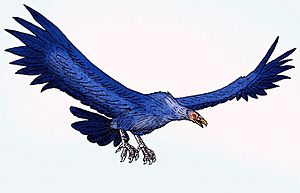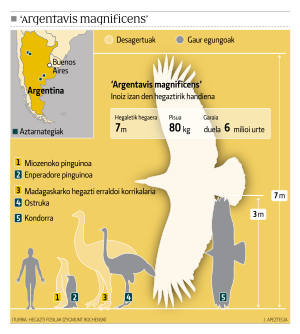Argentavis facts for kids
Quick facts for kids Argentavis |
|
|---|---|
 |
|
| Reconstruction of A. magnificens | |
| Scientific classification | |
| Genus: |
Argentavis
|
| Species: |
magnificens
|
Argentavis magnificens was one of the biggest flying birds that ever lived. It's still known as the heaviest flying bird of all time. However, another extinct bird called Pelagornis sandersi probably had a wider wingspan. Its wings were about 20% longer than Argentavis!
Argentavis magnificens, also known as the Giant Teratorn, is an extinct bird. We know about it from fossils found in three places in central and northwestern Argentina. These fossils are from the Late Miocene period.
Contents
What Was Argentavis Like?
Scientists found a part of an Argentavis upper arm bone, called a humerus. Even though it was a bit damaged, they could guess its size. The humerus of Argentavis was almost as long as a human arm!
This bird had strong, thick legs and large feet. This helped it walk easily on the ground. Its beak was big and thin, with a hooked tip. It could open its mouth very wide.
How Big Was Argentavis?

Scientists have estimated the wingspan of Argentavis in different ways. Early guesses were as wide as 7.5 to 8 m (24 ft 7 in to 26 ft 3 in). But newer studies suggest its wingspan was more likely between 5.09 to 6.5 m (16 ft 8 in to 21 ft 4 in). It's not clear if it could reach 7 m (23 ft 0 in).
When Argentavis was first discovered, it was the biggest flying bird known. But in 2014, Pelagornis sandersi was found. Its wingspan was typically 7 to 7.4 m (23 ft 0 in to 24 ft 3 in).
When Argentavis stood on the ground, it was about as tall as a person. It stood about 1.5 to 1.8 m (4 ft 11 in to 5 ft 11 in) high. Its total length, from its beak to its tail, was about 3.5 m (11 ft 6 in).
At first, scientists thought Argentavis weighed about 80 kg (180 lb). But better methods show it probably weighed around 70 to 72 kg (154 to 159 lb). This weight could change depending on conditions. Argentavis is still the heaviest flying bird known. For example, Pelagornis weighed much less, only about 22 to 40 kg (49 to 88 lb).
To compare, the largest living bird with a wide wingspan is the wandering albatross. Its wingspan averages 3 m (9 ft 10 in) and can reach 3.7 m (12 ft 2 in). Since Argentavis was a land bird, a good comparison is the Andean condor. This is the largest flying land bird alive today. It has a wingspan of up to 3.3 m (10 ft 10 in). Condors can weigh up to 15 kg (33 lb).
Scientists think New World vultures, like the condor, are the closest living relatives to Argentavis.
The largest flying creatures ever were not birds. They were pterosaurs, like Quetzalcoatlus and Hatzegopteryx. Their wingspans were estimated to be over 10 m (33 ft). Some thought they could even reach 12 m (39 ft) or more! These giant creatures could weigh around 200–250 kg (440–550 lb). When standing, they were as tall as an elephant or a small giraffe.
Here are the accepted size estimates for Argentavis:
- Wingspan: 5.09–6.5 m (16 ft 8 in – 21 ft 4 in)
- Body length: 3.5 m (11 ft 6 in)
- Height: 1.5 to 1.8 m (4 ft 11 in to 5 ft 11 in)
- Weight: 70 to 72 kg (154 to 159 lb)
How Argentavis Lived
Life Cycle
Scientists believe Argentavis laid one or two eggs every two years. Each egg weighed a bit over 1 kg (2.2 lb). This is smaller than an ostrich egg.
The birds likely incubated their eggs over the winter. The parents would take turns sitting on the eggs and finding food. Young birds probably became independent after about 16 months. But they weren't fully grown until they were about 12 years old.
Very few Argentavis birds would have died each year. Less than 2% might have died annually to keep their population healthy. Because of its huge size, Argentavis had almost no natural enemies. Most birds probably died from old age or sickness.
How Argentavis Flew
Because of its wing size and shape, Argentavis mostly flew by soaring. This means it used air currents to glide, like a glider plane. It probably flapped its wings only for short periods. It likely used warm air currents, called thermals, to stay in the air.
Scientists estimate that Argentavis needed to fly at least 11 metres per second (36 ft/s) (about 40 kilometres per hour (25 mph)). To take off, it would have needed wind. Its legs were strong enough to run or jump to start. But its wings were too long to flap well until it was already a bit off the ground.
Its chest muscles were not strong enough for long periods of flapping. Argentavis might have used mountain slopes and headwinds to take off. It could probably take off easily from even gentle slopes. It may have flown and lived much like the modern Andean condor. It would scan large areas of land from high up, looking for dead animals.
The climate in Argentina during the Late Miocene was warmer and drier than today. This would have helped the bird stay in the air using thermal updrafts. Studies on condor flight show that Argentavis could fly well in normal conditions. Large soaring birds today spend very little time flapping their wings.
What Argentavis Ate
The hunting grounds, or territories, of Argentavis were probably huge. They might have been larger than 500 square kilometres (190 sq mi). The birds would search these areas for food. They might have flown north to south to avoid strong winds.
Argentavis was probably not very good at hunting live prey. It likely preferred to eat dead animals, called carrion. It might have chased away other meat-eating mammals, like thylacosmilids, from their kills.
The biggest land predators in South America during the Miocene were giant, ground-dwelling "terror birds," called phorusrhacids. These "terror birds" were probably the toughest rivals for Argentavis. The largest species weighed about three times as much as Argentavis.
Unlike modern condors and vultures, teratorns generally had long, eagle-like beaks. Scientists believe they were active hunters. This seems true for Argentavis too. Argentavis might have used its huge wings and size to scare away mammals and smaller "terror birds" from their food.
Argentavis might also have ambushed some small live prey. This could include large rodents, small armadillos, or young animals like ground sloths. This bird would have needed about 2.5 to 5 kg (5.5 to 11.0 lb) of meat every day.
When actively hunting, Argentavis would probably swoop down from high above onto its prey. It would usually grab the prey with its beak, kill it, and swallow it without landing. However, they might also have waited on the ground. If so, they would likely stay grounded until strong winds allowed them to fly again. Its skull structure suggests it ate most of its prey whole, instead of tearing off pieces of meat.

